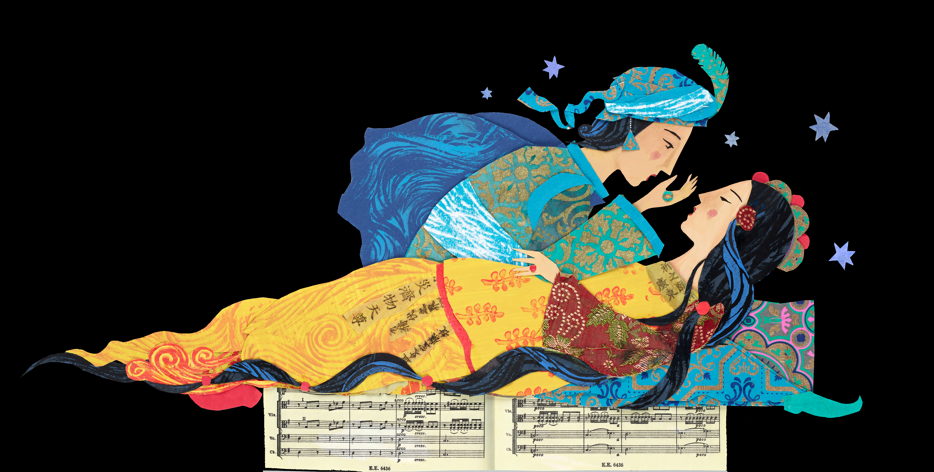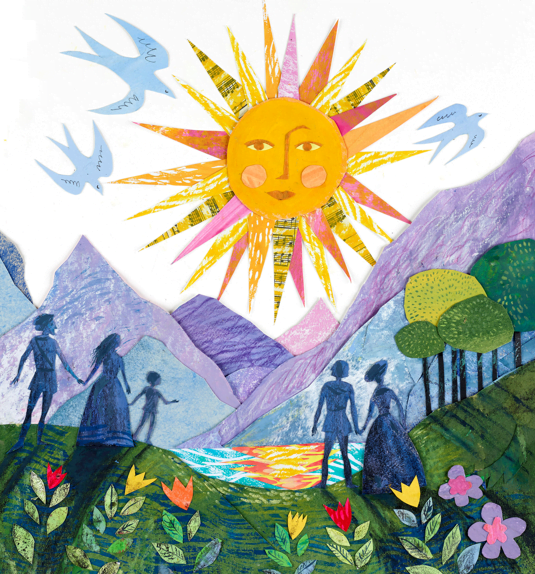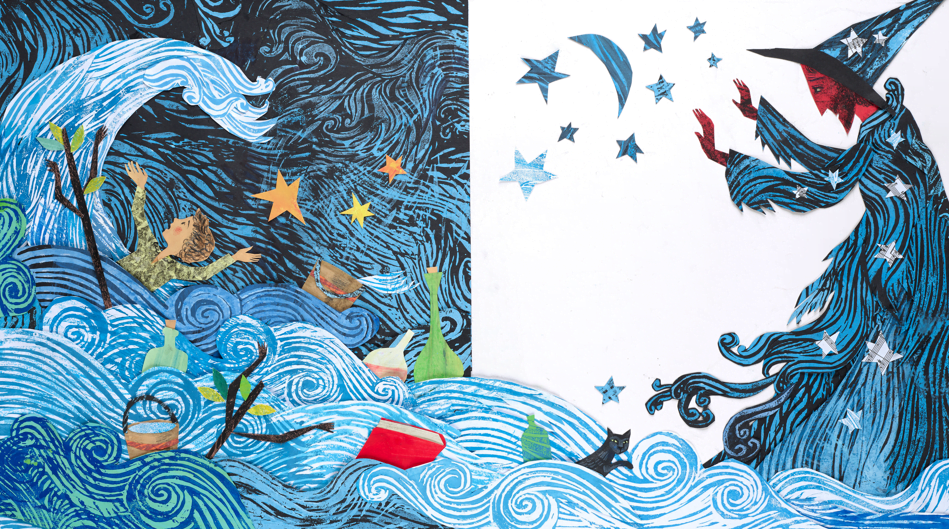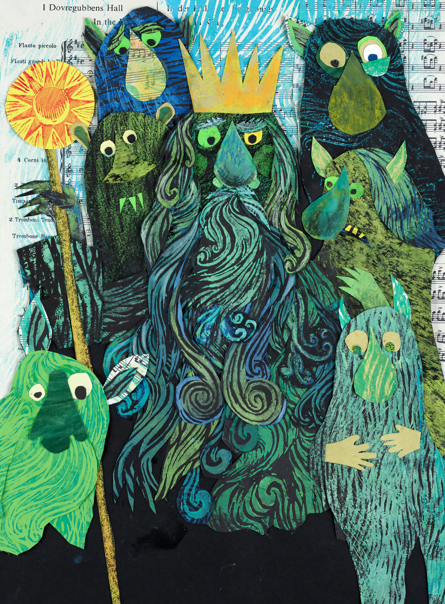What a treat today to welcome author and illustrator James Mayhew into #TheRealm to talk about his gorgeous and magical new book ONCE UPON A TUNE!
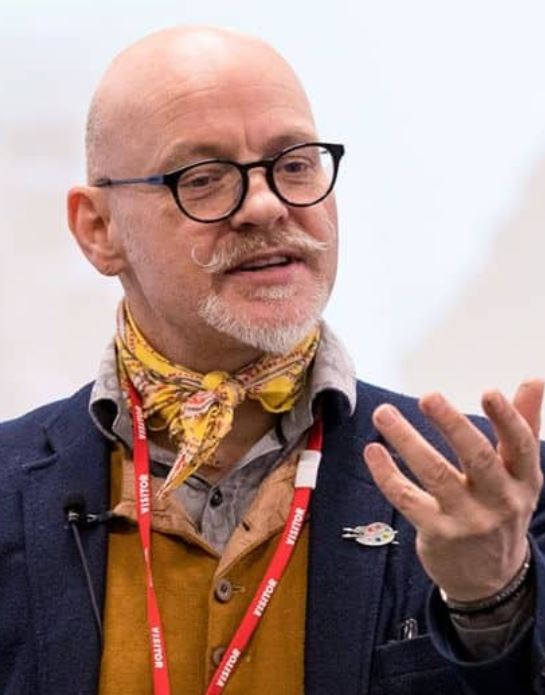
First of all, CONGRATULATIONS! Once Upon a Tune really is a thing of beauty! Can you tell us a bit about it and your inspiration for the book?
Thank you, Ian!
It’s an anthology, a big, fully illustrated book of six fantastic stories that inspired famous musical compositions by great composers.
The inspiration was the music! I didn’t grow up in a musical family, or go to concerts as a kid. I lived in a tiny village in Suffolk, miles from anywhere! But my parents had just a few classical records, amongst their Beatles LPs, and the first record I really loved was Scheherazade by Rimsky-Korsakov. It had a beautiful cover, with an illustration by Edmund Dulac. It led to a love of Dulac’s work, as well as the Arabian Nights and the music of Rimsky-Korsakov.
At school, a music teacher played LPs and told us about the stories in music – I especially remember the Dance Macabre by Saint-Saëns, with the cockerel crowing at the end. I also loved movies like Disney’s Fantasia, and Sleeping Beauty (which used tunes by Tchaikovsky). So it was always art-and-music-and-storytelling for me. Even as a kid, I drew along to the music, and was swept away, listening to these incredible sounds!
Many years later, I had an opportunity to work with an orchestra, painting illustrations, live on stage. It seemed like a dream come true – and it was! I’ve been doing these concerts for 15 years now, and I’ve been so lucky to stand on stage with some amazing orchestras and musicians, creating art live on stage during performances. The purpose has been to show children – and adults – that very often, music isn’t just a “nice tune”, but is actually telling a story. Even musicians are sometimes unaware of what the music means! So the concerts are educational, but also great fun, as the art unfolds in time to the music, up on a big screen.
Through these events, I’ve learned a lot about the music and the stories that inspired the various pieces played. So much music is based on stories! It frustrates me that these amazing works are often only heard in adverts or movies, without any appreciation of the original context for the music. Everyone knows these tunes, without knowing the stories they tell. These legends and myths are such GREAT stories, I wanted to restore the correct tales to the right tunes.
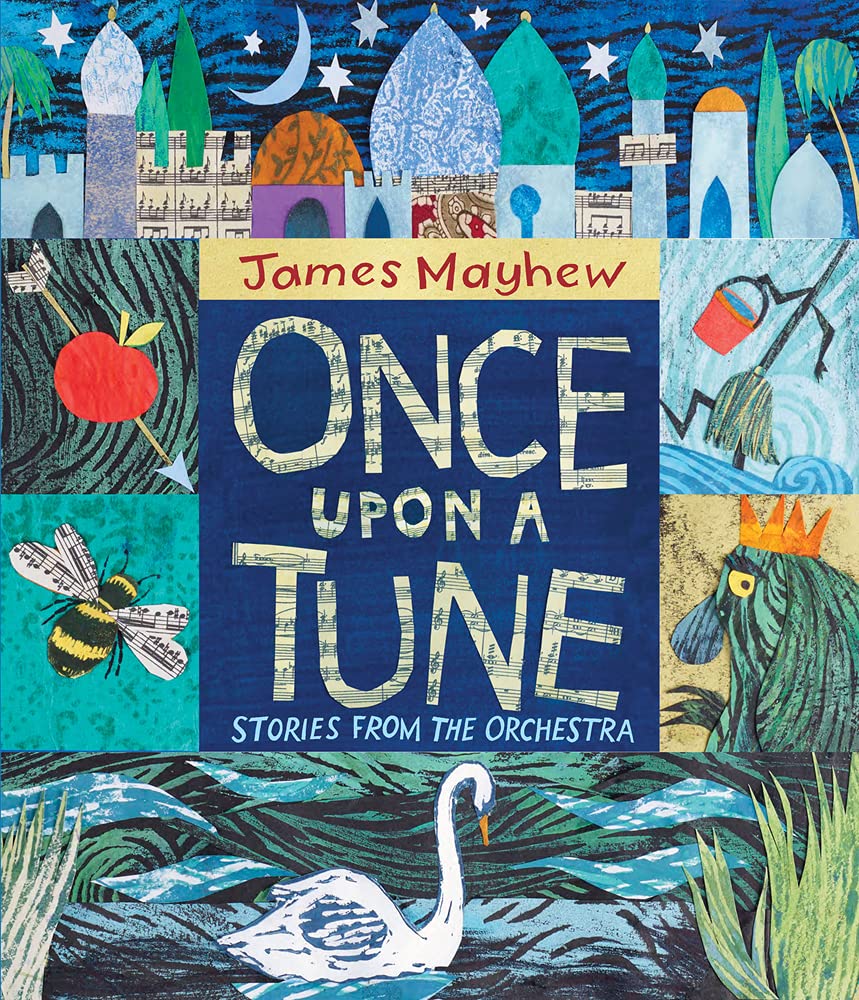
I have to ask a purely selfish question now! I LOVED The Swan of Tuonela, one of the stories included in the book. Can you tell me a bit more about the story and what attracted you to it and why you included it in the collection?
It’s a favourite of mine too! It’s probably the least familiar piece of music, but I know from working in schools, that KS2 love the dark story and the spooky music, when I use it in workshops.
The Swan of Tuonela is by the Finnish composer Jean Sibelius, and is part of a longer work called The Lemminkainen Legends. I focussed on the Swan section, as it’s a more accessible part of the myth. The stories come from a little-known collection of mythology from ancient Finland, called The Kalevala. These are EPIC myths – astonishing, magical, incredible tales, originally written in verse and chanted, or sung, hundred and hundreds of years ago.
The Swan of Tuonela is a powerful story of a rather arrogant, foolhardy hero (Lemminkainen), who is seeking the hand of the most beautiful girl in Finland. Lemminkainen travels far North, and eventually meets the girl’s mother (a witch-queen called Louhi) who sets him three tasks to win her daughter’s hand; The third is to shoot the Swan of Tuonela (the land of the dead in Finnish mythology). But it all goes badly wrong, and Lemminkainen is killed.
Lemminkainen’s mother then goes on an extraordinary journey to try to find him, and bring him back from the dead. In the Kalevala, characters can sometimes sing charms and spells, and she uses this “magic” to help her. Really the story is about a mother’s devotion to her son – she will stop at nothing to resurrect him!
I really feel the music and the stories should be better known, which is why I included it, and I hope this book inspires people to look further, and find more music by Sibelius, and read more Kalevala stories!
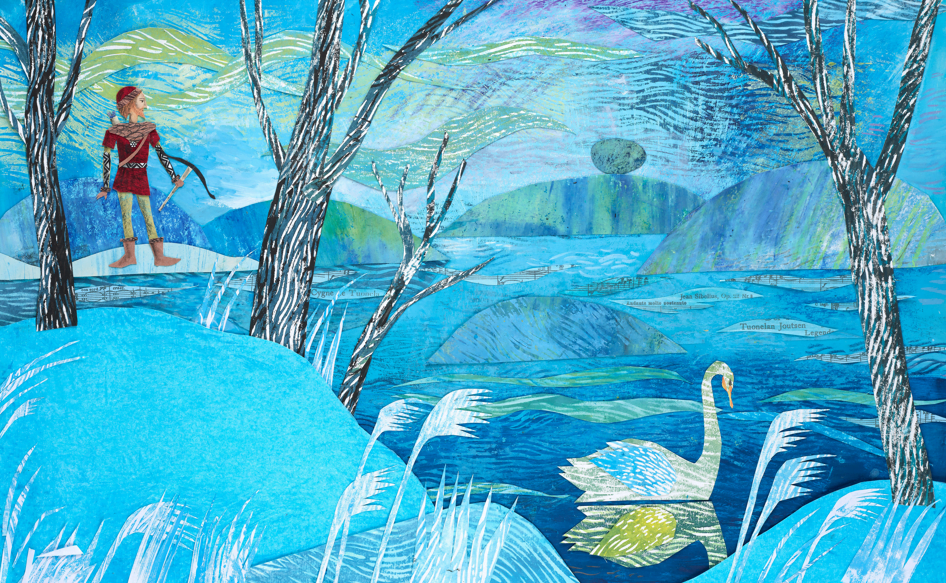
The beautiful artwork reminds me very much of the stunning work you did on the Mrs Noah series with Jackie Morris. How was the process of illustrating this book similar to illustrating Mrs Noah? How was it different?
When I developed the collage and print-making technique for Mrs Noah’s Pockets, I felt it had a “musical” quality, because the printed textures and patterns are repeated throughout the book, in a musical way. I thought it would be ideal for Once Upon A Tune. I was also able to collage sheet music – and I used the actual scores of the music in the stories!
Although the essential process of illustrating was more or less the same, a lot more planning was required. Once Upon A Tune is a BIG book, with 6 stories, and the design is very different. These illustrations curl and fit around the text and required a huge amount of careful thought. Mrs Noah books have a more straightforward graphic design.
The other big difference was the lino-prints I incorporated, they were created specifically for this book. I also incorporated a few bought printed papers, especially in Scheherazade. A visit to the Moorish palaces in the Alhambra was very inspiring, and I then found some papers in Spain with Islamic geometric designs, which were a perfect back drop for these Arabian Nights stories.
With a technique like this you are always experimenting, and surprising yourself!



I want to talk about the WRITING of the book too. Lots of people have rightly focused on the beautiful artwork but the writing is lyrical and magical too and manages to distill the essence of each legend or myth in a concise and easy to follow manner. What were the challenges of writing this collection?
That’s very kind. I LOVE writing, and I really enjoy retelling folk tales. I’ve not had many opportunities to do so, but this book, and Koshka’s Tales – Stories from Russia (Graffeg), are amongst my best written work, I think. It’s been lovely to play with words again.
The challenges were the distilling of rich complex stories into a manageable length. We actually doubled the book size. It was originally going to be 48 pages, but it wasn’t enough, so I asked for 96 – happily Janetta Otter-Barry, my editor and publisher, agreed!
These are all stories I’ve told in the concert hall, and I’ve learned what parts of the stories work, and which parts don’t, and I’ve gradually honed them, from memory, through many, many oral storytelling performances at concerts and for school workshops, to versions that I believe hold the attention and make sense for children. I have learned to put the ego to one side, and really honour the stories, and their audience, through this practise. There is no better way of editing a story than reading it to a class of children!
Each story has it’s own “tint” very much inspired by the music. Some stories are more playful, others are darker. Some are extracts from longer tales, like In the Hall of the Mountain King which comes from the epic story of Peer Gynt. I chose not to tell the whole story as some of it is rather grown up and full of curious symbolism (in the play by Ibsen). So I focussed on the famous section with the trolls.
On the other hand, for Scheherazade, I looked at the whole story. But rather than retell her Arabian Nights stories in detail (which would take too long), I only quite briefly describe a selection of her tales (specifically those related to the music), because I wanted to focus on Scheherazade herself. I was also aware that stories like hers have traditionally been told in a way that is quite dark (the Sultan is really a terrible misogynist!), so I tried to focus on Scheherazade as a brilliant, powerful, clever woman, and make it feel triumphant – because I think that is what the music is saying – the final bars are quite simply ecstatic, as she wins the Sultan’s love and respect, after a thousand and one nights of telling tales. Wonderful music! I hope I’ve done it justice.
William Tell was a different kind of tale again, rooted more in the real world, with politics underlying it. But I find the theme of freedom, or liberation, very moving. I think all these stories should have people listening to such famous music a little differently, and with rich, emotional layers.
When I was training to be a teacher, I had one half day on my PGCE course where we explored music in the classroom! Despite playing the piano, I never felt confident teaching music to children. What are your three top tips for teachers who want to use Once Upon a Tune in their classroom but perhaps feel nervous or unprepared about exploring classical music?
The first thing to say is – be open minded. You don’t need to be a music teacher or read music to enjoy the stories in this book. Ditch your preconceptions, and give it a try! So many people think “Classical” music is highbrow, or boring. But it can be incredibly powerful, dramatic, emotional, inspiring and stimulating! All the pieces in this book demonstrate different sides to orchestral music. Otter-Barry Books have also created really fantastic resources to support the book, in the class-room, or at home. You’ll find these “Explorer Notes” on their website.
I see teachers doing AMAZING things in classrooms with art, and with this book, I’m sure they’ll easily be able to do exciting things incorporating music.
My three big tips are:
- SOUND QUALITY – it makes such a difference if the music can be heard properly. It becomes an immersive experience. After reading them a story from the book, lower the lights, put illustrations on the screen, and let the music work it’s magic. Make it an event. Make it *special*. There will be SO MUCH to talk about afterwards. Don’t feel overwhelmed – start with just one story, one piece of music.
- Try introducing painting/drawing to music – far and away the most meaningful and successful workshops I’ve done in 30 years of school visits, have been where the children create art to music. A great way to get children to really concentrate. The “Explorer Notes” have extensive guidance on this, including art materials. It works because it takes music away from being just abstract (if harmonic) sound into something meaningful, through story and art.
- Remember, music education isn’t *just* about learning to play an instrument. Learning to listen, to understand, to enjoy music is such a great gift. You don’t have to be an artist to go to a gallery. You don’t need to play an instrument to enjoy a concert – if you know how to listen, and use imagination. Just as the Katie books open up the world of galleries, this book can open your ears to music.
Let’s play Devil’s Advocate for a moment and imagine that I’m someone who believes that music and the arts has no place in a post-pandemic classroom. Let’s imagine that I believe that we should focus solely on English and Maths because the children have lost so much learning time! What might you say to convince me otherwise?
This is such a fantastic question. There are many angles to answer. What kept us sane in the pandemic? who watched TV? Who watched movies? How many things had *orchestral* music (or even “classical” music) in them? Although… I think it’s really important to not just see the arts as “entertainment”, or an “add on” in life. Everything man-made involves design – just consider that for a moment. The “Arts”, like all subject, don’t fit neatly into a small box. They expand over all areas of learning, all areas of our life, from the shoes we wear to the homes we live in, the books and entertainment we enjoy. . Everything benefits from creativity.
But actually, I want to dive in and talk about mental health. Big taboo, even today! When I do painting to music workshops in schools, I see something extraordinary happen. I see autistic children come out from under tables, where they like to hide, to join in and create – and listen. I have had elective mutes begin talking. I’ve seen unhappy, troubled children become radiant with pride because of what they have created in response to the music. I’ve seen children create purely illustrative responses, drawing the story, while others paint something entirely abstract, an emotional, patterned reaction to the story, like sound-waves. I’ve seen whole classes, hushed with concentration, lost in the music, lost in their art. I’ve had classes begging to hear the music again, because by now they “own” it; it belongs to them, and always will. I’ve seen outstanding story writing following on from these sessions, retelling the tales or inventing new ones, with the music, always moving forward, as a guide to remembering and inspiring. I’ve visited challenging schools with international children of many tongues, pulled together by this most universal of languages. I’ve visited Special Needs schools and seen even the most unresponsive children move, sway, and moan to the music. I’ve seen teachers in tears of joy. I need to emphasis that this isn’t me! I take no credit. It is the power of music!
In terms of further justification in the classroom, a book like this has huge cross-curricular potential. I realise music education and the arts are hard to squeeze in. Cuts in funds and time, and pressures to perform well in league tables all take their toll. However, by using music as a cross-curricular subject, you can actually find ways to include music alongside what you were going to teach anyway. Obviously there is literacy (English), Music and Art. We also have stories from China, India, Persia, Norway, Germany, Russia, Switzerland and Finland, and things like weather and the seasons feature strongly in “programmatic” music – there’s a wonderful storm in the William Tell overture! so there’s Geography covered. These are historical stories, often relating to great writers: Pushkin, Ibsen, Goethe, and different cultures in different times, History can really be enhanced with music. If you study the Victorians, what were they listening to? There is Science (Magic potions, like the Sorcerer’s Apprentice), there is Drama (create a troll dance to In The Hall of the Mountain King); we know that children who are musical are often better at Maths – there is so much potential – and the free “Explorer Notes” will help guide you.
To conclude, of course the core subjects are important, of course children need to catch up. But children have been through a lot in this pandemic. It’s been disruptive, confusing and worrying for them, a discombobulating time. Music can bring unity, pattern, familiarity, calm and concentration. Music can create a strong focus in any classroom. It can also bring release and refreshment. Above all, it brings solace and joy to us all.
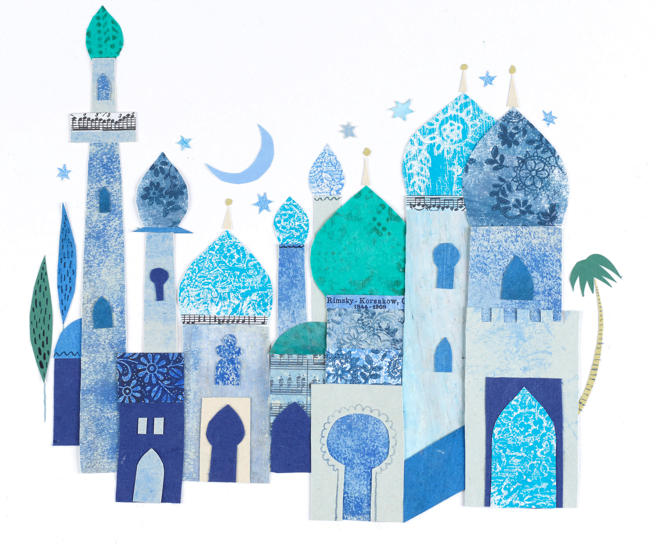
Finally, I wonder if you can tell us a bit more about any other projects at you’re working on linked to Once Upon a Tune – I’m hoping there might be some live shows and orchestras involved!
Creating the “Explorer Notes” has kept me busy for a while, and I’ve had a wonderful musician friend, a pianist called Siu Chui Li, to help me, and I’m really proud of what we are offering. I’m also illustrating a new Mrs Noah title by Jackie Morris, appropriately called Mrs Noah’s Song.
But I am so excited that, after a long wait, concerts are starting to go ahead again. I have an event at the Cheltenham Literature Festival, which will include some music. The other big event is a pair of concerts in November, with the Sheffield Philharmonic Orchestra. Expert conductor and arranger George Morton has made the music work for a smaller orchestra, so they can socially distance if necessary, and I’ll be presenting the tales from Once Upon A Tune, and painting live with them on November 6th – it should be an amazing day. Many think classical music is too exclusive or expensive, but these concerts are so accessible, fun, and cheaper than a trip to the cinema!
This is music for everyone, for all time!

